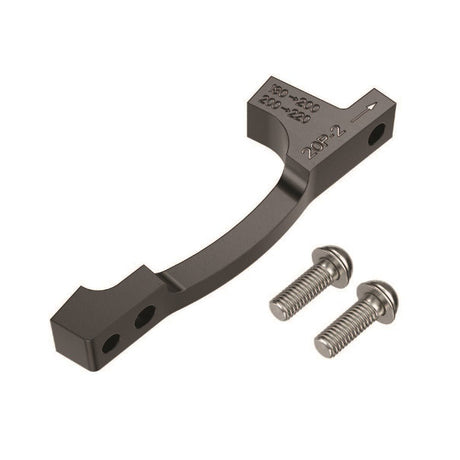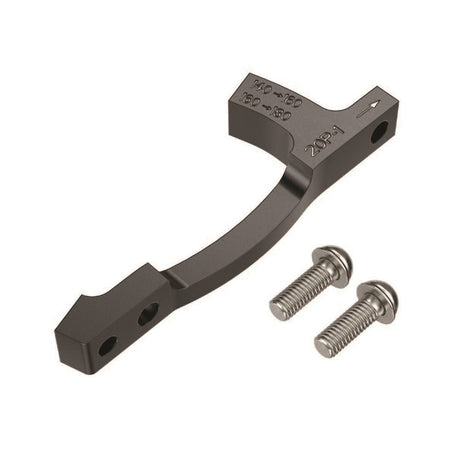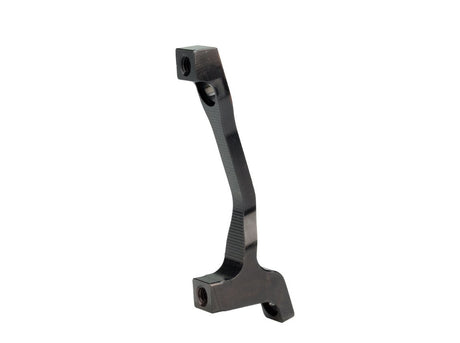Intro
If you’re building a new bike from the ground up or upgrading your to larger rotors, you'll need the correct brake adapters to ensure correct alignment between your brake pads and rotors.
These little chunks of metal seem incredibly confusing, but they’re really quite simple. In this article, we will explain exactly how brake adapters work and how to choose the correct one for your application.
Brake Adapters At A Glance
- Brake adapters place your brake calipers in the perfect spot to correctly maximize the contact patch between your brake pads and rotors.
- There are two types of brake mounts on frames and forks: IS and Post Mount.
- Forks and frames are designed around a certain size of brake rotor, known as their “native” size.
- You do not need a brake adapter when using the same size rotor as your frame or fork’s native size.
- You will need a brake adapter to space the brake caliper away from the fork or frame when installing a rotor larger than the native size.
What Are Brake Adapters For
Brake adapters on mountain bikes are used to space your brake caliper to the correct position in order to align your caliper and rotor for a proper contact patch between the two.
Some complete bikes have a brake adapter on both the front and rear brake calipers, but some do not. If your complete bike does come with adapters, you will likely never think twice about them. However, once you want to increase (or decrease) the size of the rotors your bike came with, you will then have to install the correct brake adapters to accommodate for the larger (or smaller) diameter of your new rotors.
If you don’t install the correct adapters, your brake pads will not contact the rotors sufficiently, resulting in virtually zero braking power. Even small changes make a big difference. For example, if your bike is set up for a 203mm rotor and you switch to a 200mm rotor, it seems like 3mm of difference won’t make a big deal. However, you will still need to install the proper adapter for a 200mm rotor as the 203mm adapter spaces the caliper outward enough that about 10% of the brake pad won’t contact the rotor. This will decrease braking power, leave your brake pad with a ridge of unused material at the top of the pad, and may result in some weird noises and lever feel.
Brake Caliper Mount Types
There are two different designs in which brake calipers are fixed to the fork in the front and the frame in the rear. These are “Post-Mount” and “IS”. Post-Mount (commonly listed as PM) is the most common type these days, and have pretty much been the standard on aluminum mountain bikes and most forks for at least a decade. IS stands for “International Standard” and is mainly used on steel bikes and some entry-level forks.
There is also what is known as “flat-mount” brake mounting, but that is mainly used on road & gravel bikes so we won’t get into that here today.
There are certain configurations where you will have a different brake mount on the front and rear, and that is normal. Many steel hardtails will have an IS mount on the frame, but most forks use post-mount.
You can easily tell if you have post-mount or IS mounts by simply taking a peek at your bike. If there are two holes that are unthreaded where the bolt would travel perpendicular towards the center of the bike, that is an IS mount. But if your fork or frame has two holes that are threaded, and the bolts would travel parallel with the frame/fork, that is post-mount.
Post-Mount
IS Mount
What Size Adapter Do I Need For My Rotor Size?
IS mounts are super easy, so let’s get that out of the way first. If you have an IS mount, all you need to do is get a brake adapter listed as “IS to Xmm”. So if you have an IS mount and are using a 180mm rotor, you simply install a brake adapter listed as “IS to 180mm”. Super easy!
Now onto post-mount, which is slightly trickier but not too bad. The first thing you need to do is figure out the “native” post mount size of your fork or frame. The native rotor size refers to which size of rotor matches up perfectly with the brake caliper bolted directly to the fork or frame without any type of brake adapter or spacer between the caliper and fork/frame.
You can find the native size in one of three methods.
The first method is to look at your bike and see if it already has brake adapters or not. If one or both of your brakes do not have brake adapters, then you have it easy. For example, if the rear brake does not have a brake adapter between the caliper and frame, and you have a 180mm rotor, then your frame’s native brake mount size is “post-mount 180”. The same applies to your fork’s brake mount.
If your fork or frame does have a brake adapter, it’s slightly trickier to figure out the native size. So for the second method, I usually like to pull up the frame or fork manufacturer’s website page and cross my fingers in hopes that it's listed on their site in the technical information. 99% of the time, you can find the native size there, however, this is not always the case.
If not, the third method is to figure out which brake adapters are currently installed. On the installed brake adapter, you will find some writing that tells you either your native rotor size and the size of your current rotor, or the difference between your current brake rotor size and your native size. You may need to uninstall and clean your adapter to find this.
For the first case, it’s very straightforward to find your native size. The smaller of the two numbers is your native size, and the larger of the two is your current rotor size. For example, if the adapter says “160PM to 180PM”, your native rotor size is 160mm and your current rotor size is 180mm.
The second case will test your second grade math skills. Find the size of your current rotor, which should be printed on the side of it, and subtract the number you found on your brake adapter from it to find your native saize. For example, if the adapter says “+20mm” and your rotor is 200mm, then your native size is 180mm.
Choosing The Correct Brake Adapter
Now that you know your native brake mount size, the hard job is done. Now, all you need to do is choose the correct brake adapter for proper spacing and alignment between your caliper, pads and rotor.
Depending on the brand of brake adapter, they might be labeled in one of two ways. For example, if your frame/fork has a 180mm post-mount and you’re going to use a 200mm rotor, the difference in sizes here is 20mm. Some brands might label their adaptor for this configuration as “180PM to 200PM” while others might label theirs as “+20mm”. In this scenario, both of these will work correctly as the difference between the native rotor size and the desired rotor size is the same on both (20mm).
You can apply this same principle to any configuration, and that’s really all there is to it. All you’re doing is adding spacing from the native rotor size to adapt it to your desired rotor size, and you just use an adapter that spaces it outward.
Besides the correct spacing, you’re probably wondering which brand of adapter you need to use. Ninety-percent of the time we use Shimano brake adaptors as they are the cheapest and seem to be compatible with almost all brands of brake calipers. The brand of the brake caliper and brake adapter don’t usually have to match in most cases. However, we have seen certain configurations have slight clearance issues when mixing brands of calipers and adapters, so the safest bet is to match the brand of brake caliper and brake adapter.
No matter the brand you choose to use, the same principles applies to all of them. One thing to take note of is that certain brands have wildly confusing naming conventions such as Shimano. They list different spacing for front and rear use in some cases, but that is really not applicable to post-mount adapters and we’re not sure why they do this. On certain brands of adapters we have changed their name on our website to simplify the selection since it just doesn’t need to be that confusing.
Summary
Hopefully you feel some relief on choosing brake adapters after reading this article, because it really is quite simple once you understand a few quick fundamentals. Knowing what the native mount size is on your frame or fork is a very important step to figuring out what size adapters you need for the rotor size you want on your mountain bike.
You can shop through our huge selection of brake adapters as we carry a wide variety. If you have further questions on brake adapters, don’t hesitate to contact us as we will be more than happy to help!




